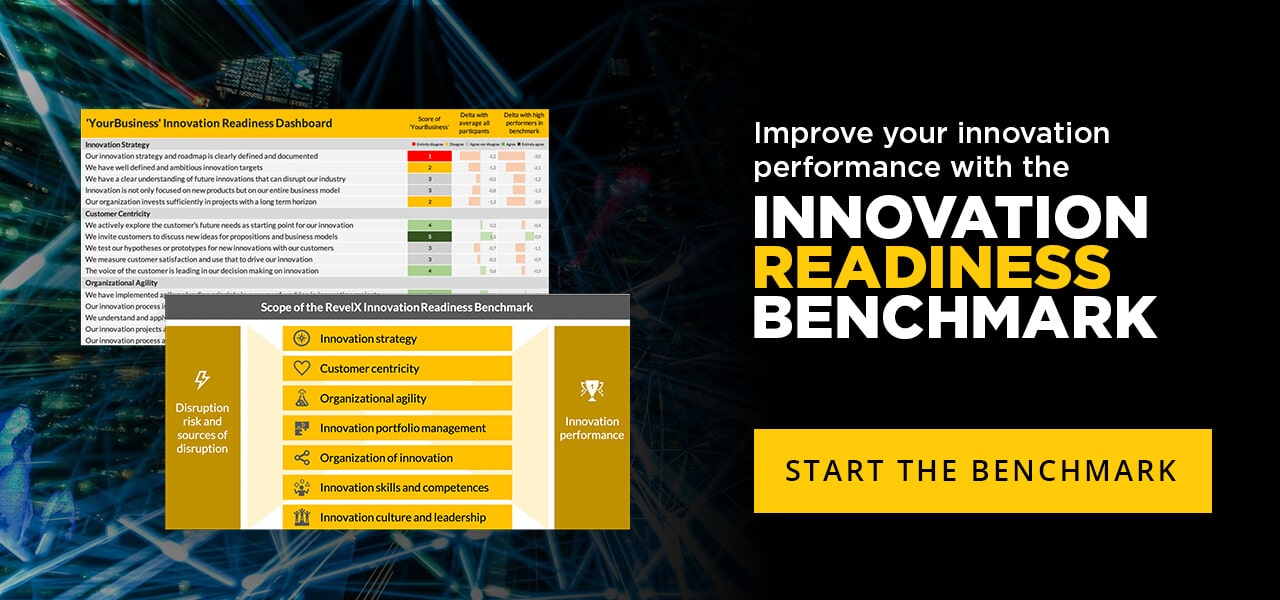Recently our colleague Matthijs Rosman was invited as keynote speaker at the annual industry conference of the international office supply industry. His talk on Disruption was well received and was found to be one of the more inspiring talks the participants had experienced in a while.
Since we at RevelX care about sharing our knowhow with anyone who might benefit from it, we decided to publish this keynote in the form of a series of blogposts, of which this is the first.
The series will consist of three parts:
- Introduction to disruption and the disruption process
- Any industry can be disrupted and disruption’s leading indicators
- Strategies to counter disruption or become a disrupter yourself
Happy reading!
Introduction to disruption and the disruption process
The world is rapidly becoming a different place
We live in times of unprecedented change. In order to cope we have to master the management of uncertainty. In many perspectives we find ourselves in unchartered territory. Never in our lifetime have we seen this amount of change with this impact.
Especially now, in a time where we have to find our bearings in this COVID-19 reality, we are tested in our ability to adapt. It is not difficult to find yourself exposed to existential issues. We are truly experiencing a reset.
I have borrowed the term ‘The Great Reset’ from the World Economic Forum. What I like about the term ‘reset’ is that it holds a promise. It is something that embodies opportunity. It allows us to take a hard look at who we are and what we want and can be. In life. But also as business. Just to be sure not to waste this crisis.
We have the power to reinvent ourselves. To decode what we are and to recode ourselves to be fit for the future.
COVID-19 is turning out to be a great disruptor. But we have been disrupted before. And still, here we are. I believe in the mantra ‘never waste a good crisis’. Companies who are willing to use this reset will come out on top.
Disruption is a process, yes it is
Disruption is a process where major shifts in an industry’s order are brought about. Incumbent players must rethink their businesses to stay relevant in the face of the changed industry dynamics.
We often hear about disruption from small startup companies. Seemingly insignificant players upsetting large companies. Either forcing them out of business or leading to a significant change in course.

The inspiring case of Netflix
A famous example of industry disruption is the case of Netflix. Netflix was founded in 1997 in Scotts Dale, Arizona by Reed Hastings. It rode on the back of the introduction of the DVD player earlier that year. The DVD player was aimed at providing a cinema-quality experience to serious movie fans.
Netflix’ service was based on a subscription model through which people received DVDs by mail. Either to rent or to buy. The service was far from ideal since it lacked presence. Availability of movies was sparse; Sony was slapped with many lawsuits by film makers who did not want their titles to redistributed through DVDs. Also, the service lacked the instant gratification a VHS rental outlet provided. So, Netflix customers had to accept all these limitations in lieu of high-quality audio and video.
The market for movie rental was dominated in the time by Blockbuster. The franchise had many-thousands outlets across the country. It enjoyed mega marketing budgets and was highly profitable. That profitability was boosted by the fact that Blockbuster levied stringent late fees on tapes returned after their due date.
Netflix’ business grew steadily over time. Early 2000, Reed Hastings traveled to Dallas, Texas to meet the CEO of Blockbuster, John Antioco. Hastings proposed a partnership: Blockbuster would promote Netflix’ DVD business in its many outlets and Netflix would help Blockbuster online. Antioco was not receptive for the idea and booted Hastings out of the building.
Fast forward to 2010: Blockbuster filed for bankruptcy with a foreclosure value of $290 million dollar. Netflix is now worth $230 billion dollars (market capitalization). Similar to Disney’s market value.
The process explained
The notion of disruption has been coined by the late Clayton Christensen. He talked about disruption innovation. In his explanation of the concept “Disruption” describes a process whereby a smaller company with fewer resources can successfully challenge established incumbent businesses.
Disruptive entrants get a hold on a market when incumbent players focus on improving their products and services for their most demanding customers. Thereby exceeding the needs of others. The entrant taps into overlooked market segments which are not effectively served. They gain a foothold by offering a proposition with more suitable functionality at a lower price. When mainstream customers start to adopt the entrants’ offering in volume, the market has been disrupted.
We see one of two trajectories for industry disruptors: the low-end foothold as just discussed. Or the new market foothold. In this case, entrants create a new market by offering a proposition to a not previously catered to segment.
Disruptors start by eating away at your market share and then eat into your profitability.
Contrary to popular belief, companies like Uber and Tesla are not disruptive innovators. Uber offered a better, less-expensive solution to a widespread customer need. Tesla has invented a car which enabled the masses to move away from the combustible engine and enlarged the market for electronic vehicles.
Blockbuster did not see the threat of the insignificant Netflix. Netflix targeted a niche market. In the eyes of Blockbuster, Netflix was inferior.
In our next blog we will show evidence that any industry can be disrupted and share a set of leading indicators that may warn you in case your industry is about to be disrupted.
Matthijs Rosman
Trusted and creative advisor. Specialist in growth acceleration and innovation. Combines analysis and creativity to develop surprising combinations. From new digital possibilities to ways to improve commercial results. Cordial towards others, sharp on details. Continuously looking for growth opportunities.
Related posts
Strategies to counter disruption or to become a disrupter yourself
We see the same things happening in the business world.…
January 7, 2021
Early warning signals for disruption
Any industry can be disrupted. Netflix is a famous example.…
December 15, 2020
What Are the 5 Key Drivers for Growth?
To build a successful organization, first make sure the…
October 23, 2020



